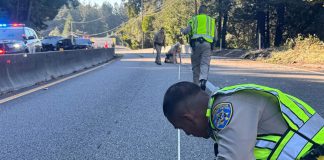The County Planning Department knows there are hundreds of unpermitted dwellings throughout the unincorporated areas of Santa Cruz County, especially up and down the San Lorenzo Valley. Aimed at insuring a basic level of health and fire safety in these living spaces, the county has rolled out a new “Limited Immunity Amnesty Program,” called the Safe Structures Program, to improve the safety of both residents and neighbors of these “not-entirely-legal” residential spaces, while trying to avoid the dreaded “Red Tag” that puts people out of much needed affordable housing.
The Safe Structures Program offers limited immunity from any further code enforcement once basic health and fire safety standards are met. Unpermitted remodels, room additions, as well as stand-alone Accessory Dwelling Units (ADU’s or “granny flats”) are eligible for this “limited amnesty” from code enforcement, as long as they are certified by county building inspectors as meeting minimum requirements, and the “unpermitted space” was built prior to January 2014.
Code compliance officials are often caught between the “rock” of neighbor complaints about an illegal structure or unpermitted use of space for a dwelling and a “hard place” of evicting people from an affordable place to live. The Safe Structures Program is aimed at providing some middle ground in code enforcement- a way to improve safety, reduce the liability of the property owner, and putting the property on a path toward legality, all with the property owner’s cooperation.
“While legal construction should always be the goal, the County recognizes that many of existing unpermitted structures are being put to beneficial use and have existed in the community for years. As long as safety and habitability can be ensured, the continued use of these structures can be in the public interest, especially given the shortage of available housing and very high housing costs,” according to the online program description.
“The program is designed to encourage people who can get legal, to become legal,” said County Building Official Marty Heany. Heany used an example of an unpermitted structure or addition that violates a property line set-back requirement, that can’t be remedied without tearing it down, but otherwise meets the basic health and safety requirements of the program. After this space is inspected and certified as meeting basic health and safety code requirements, its set-back violation would be put “on back burner- as a low-priority,” Heany said.
In such a case, if Code Compliance receives complaints about this property, with regard to the structure being too close to the property line, “the County will indicate that the property is safe and habitable and considered a low priority for code enforcement efforts”, according to the county’s project description of the Safe Structures Program.
“But the program is not a carte blanche pass for unpermitted buildings,” Heany points out. “If we catch a property owner doing active building without permits after the safety certification, we’ll throw away the limited liability from further code enforcement,” Heany added.
The Safe Structures Program comes on the heels of streamlined permitting for ADU’s in the unincorporated county. Some of this streamlining was required by recent changes in state law, intended to cut through local barriers to building ADU’s. For example, state law limited the parking requirements that local governments could require for new ADU’s, and, in some cases, illuminated the requirement for fire sprinklers.
Significant for many properties in the San Lorenzo Valley, those homes served by on-site septic systems were previously not allowed to add an ADU without a new septic system. Now, upon application, the current septic system will be checked if it can handle the additional load of a proposed or unpermitted ADU.
These new state and county regulations have made it easier to legalize an unpermitted ADU, and the Safe Structures Program reduces the risk a landlord takes in renting an unpermitted dwelling. Landlords who are renting unsafe or illegal dwellings can be required to pay up to three months of tenant relocation assistance if the property is “Red Tagged.” With a certification for the Safe Structures Program, this liability is taken away.
Applicants to the Safe Structure Program are required to pay a special inspection fee of $500, as well as a zoning check fee of $300. If the improvements necessary for the “limited liability” certification prove too expensive, or the property owner decides to opt out of the certification process for other reasons, the county will not follow-up on the code violations identified in the inspection, unless a serious, “imminent hazard to health and safety” issue was identified. The “limited amnesty” from future, complaint-driven code enforcement will also not come into effect without the certification.
More information about the Safe Structures Program, formerly referred to as the Limited Immunity Amnesty Program, is available at the County Planning Department’s website at: http://www.sccoplanning.com.










